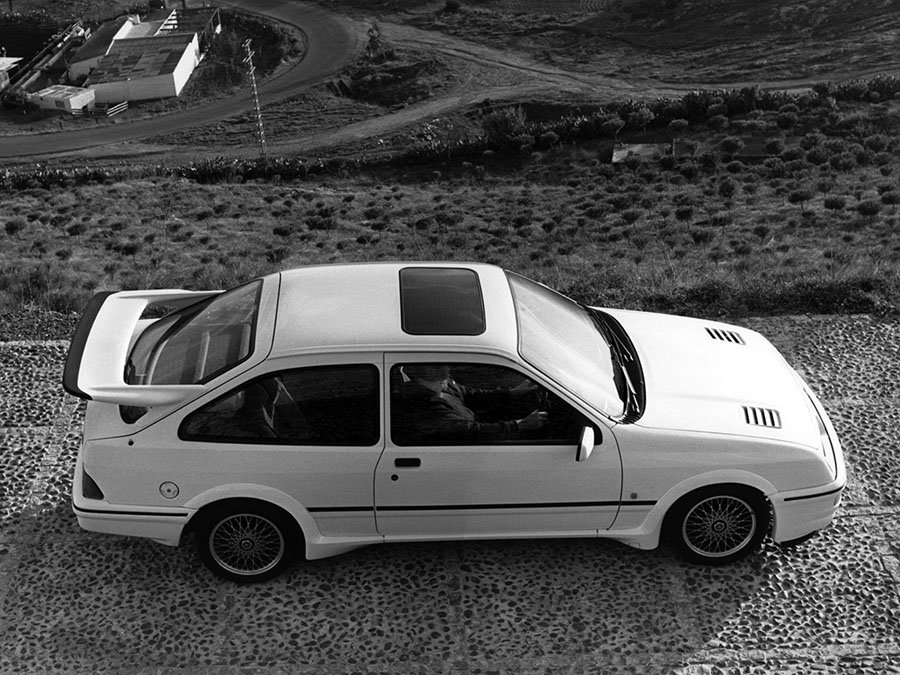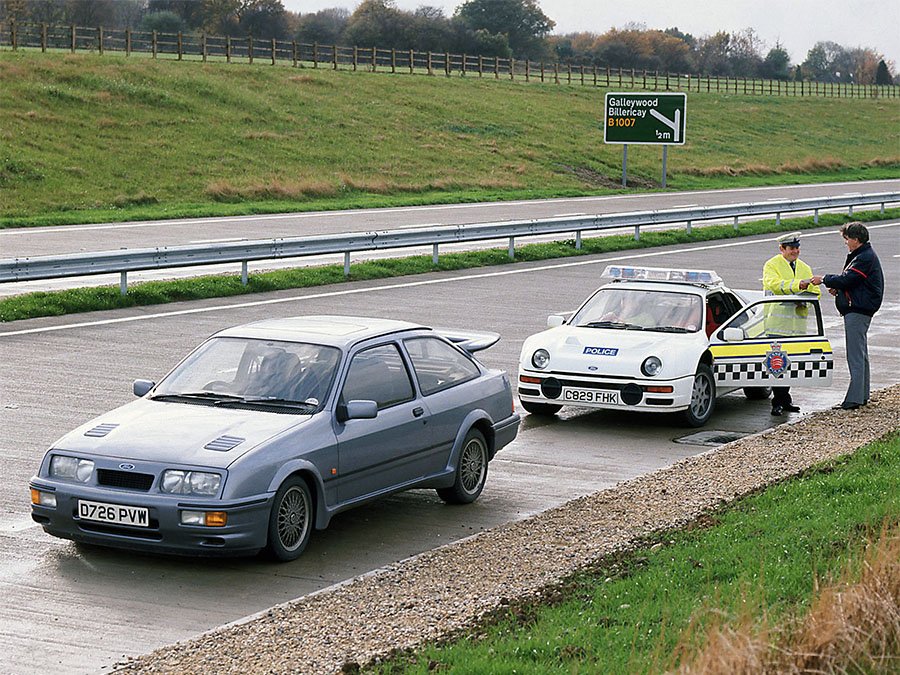Guide: Ford Sierra RS Cosworth - a Historical & Technical Appraisal
/BACKGROUND
When Stuart Turner was appointed as head of Ford Motorsport in March 1983, he quickly decided to abandon the firm’s existing competition programmes.
This meant the troubled RS1700T Group B challenger was ditched along with any further work on the recently homologated Group A RS1600i (both of which were derived from the Mk3 Escort).
The C100 Sports Prototype was also killed off and Ford would officially play no further part in the Group C era.
Turner realised that to succeed in Group B and Group A, Ford would need more than a couple of half-baked Escort-based machines. A brand new mid-engined four-wheel drive model was thus created for Group B rallying (the RS200) along with a tricked out homologation special based on the recently introduced Sierra for Group A touring car racing.
The Sierra platform was chosen as the basis for a Group A contender on account of its slippery shape and perfect size. Commercially, the Sierra had proven something of a slow seller since its 1982 introduction; a high profile racing programme along with an exciting new flagship would add a little sparkle to the range.
To power the new machine, Ford turned to Cosworth Engineering with whom they had a long-standing relationship.
Most famously, Cosworth had developed the all-conquering Ford DFV engine that dominated Formula 1 throughout much of the late 1960s and 1970s. Cosworth also created the Ford BDA motor that proved enormously effective in Escort racing and rally cars (as well as single seaters) during the same period.
To power the new Group A challenger, Ford asked Cosworth to develop a turbocharged version of the Sierra’s two-litre inline ‘four’.
Cosworth agreed, but told Ford they would need to place an order for 15,000 such engines. This was far in excess of the number required by Group A which demanded a production run of 5000 identical cars within a twelve month timeframe.
Nevertheless, Ford agreed and the surplus engines were later used in some of the firm’s other high performance models.
The resultant Sierra RS Cosworth was presented at the Geneva Motor Show in March 1985. It was the first production car to wear the Cosworth badge, but the reaction from Ford’s Rallye Sport dealers was not initially encouraging. Having been told they would be unlikely to sell more than 1500 of the brutish-looking machines, Ford took steps to ensure the Sierra Cosworth could be sold for as cheap a price as possible.
Ford had hoped to begin deliveries in September 1985, but production did not begin until July 1986.
The 5000 cars required had rolled out of Ford’s Genk factory in Belgium by December of that year and Group A homologation was approved on January 1st 1987.
ENGINE / TRANSMISSION
Cosworth based the new engine around Ford’s cast-iron T88 Pinto block: a water-cooled inline ‘four’ that displaced 1993cc thanks to a bore and stroke of 90.8mm and 76.95mm respectively.
A special light alloy head was created that featured two belt-driven overhead camshafts operating 16 valves (eight 35mm diameter inlet and eight 31mm exhaust).
Mahle pistons with forged steel connecting rods were added together with a forged steel crankshaft, a new oil pump, a special cast aluminium sump and a free-flow exhaust. Cosworth also fitted a Garrett AiResearch T03B turbocharger (set at 0.7 bar) and an an air-to-air intercooler.
Wet-sump lubrication was employed along with an 8.0:1 compression ratio and Weber-Marelli digital engine management with electronic port fuel-injection.
The YBB motor fitted to the Sierra Cosworth was the first production car engine to produce more than 100bhp per litre. It pumped out 201bhp at 6000rpm and 204lb-ft at 4500rpm.
For comparison, the 2.8-litre V6-powered Sierra XR4i produced 160bhp at 5700rpm and 159lb-ft at 4300rpm.
To handle the power and torque on offer, Ford needed a beefier gearbox than was already being used in the rest of the Sierra range. They opted for a five-speed manual Borg Warner T5 which was a specially configured version of the type used in the Mustang. Transmission was through a hydraulic single-plate clutch and viscous-coupling limited-slip differential.
CHASSIS
Each RS Cosworth started life as a standard Sierra bodyshell with a 2608mm wheelbase.
Accordingly, the existing suspension layout was retained: MacPherson struts with lower control arms at the front and semi-trailing arms at the rear.
To improve handling, stiffer coil springs, firmer dampers and thick new anti-roll bars were installed.
A quicker power-assisted steering rack was fitted as was a special ABS system developed in conjunction with ATE.
283mm diameter ventilated discs and four-piston calipers were mounted up front.
The bank end ran 273mm solid discs with single-piston floating calipers.
Rial 15 x 7 cross-spoke alloy wheels had a four stud fixing that was concealed with a centre cap that gave the appearance of a centre-lock effect. Dunlop tyres were originally fitted and track was 16mm wider at the rear of the car.
A standard 60-litre fuel tank was located in the boot floor.
BODYWORK
To improve cooling, increase downforce and enable the use of dramatically wider wheels in racing, Ford equipped the Sierra Cosworth with body kit that made it one of the most recognisable cars of the 1980s.
Because the standard Sierra hatchback developed a significant amount of lift, some major revisions were needed to make it stable at the kinds of speeds expected to be achieved on track.
Following intensive wind tunnel tests and a series of high speed runs at the Nardo bowl in Italy, Ford opted to install a massive rear spoiler supported by the C-pillars and a single central pylon. The spoiler (which was essential for racing) gave the Sierra Cosworth its signature look and featured a trailing edge left in natural black rubber. At the front of the car, a deep wraparound chin spoiler was finished to match.
A unique front bumper incorporated an array of large cooling intakes for the brakes and radiator. The nose panel above (which shrouded the headlights) featured a substantial opening to feed the intercooler.
To enable hot air to escape from the engine bay, two banks of vents were added to the hood.
Wheelarch extensions were fitted at either end and joined by deep side skirts. A custom rear bumper was installed at the back.
All the Sierra Cosworth’s bodywork additions (the bumpers, wheelarch extensions, side skirts, rear spoiler, nose shroud and hood vents) were moulded from lightweight fibreglass. The rest of the body panels were steel.
As increased downforce was predominantly the name of the game, it was no surprise the car’s drag coefficient rose from 0.32 to 0.345.
INTERIOR
Inside were special Recaro seats and a small diameter leather-rimmed three-spoke steering wheel. The other new item was a turbo boost gauge. Otherwise, the Sierra Cosworth was kitted out to Ford’s top-of-the-range Ghia equipment level.
The velour seats were trimmed with red and black-patterned centres and grey fabric elsewhere. This same red and black pattern was also applied to the velour door panels and rear side panels. The split rear seats could be lowered to provide an enormous load area.
The hard grey plastic dash was home to an instrument binnacle directly behind the steering wheel and a centre console that was angled towards the driver.
Instrumentation comprised large analogue read outs for road and engine speed together with smaller dials for turbo boost, fuel and water temperature.
Standard equipment included a quartz clock, a leather gear knob, a four-speaker radio cassette player with electric antenna, tinted glass, a tilting glass sunroof and electric heated door mirrors.
OPTIONS
To keep costs down, Ford offered a choice of just three exterior colours; Diamond White was the no-cost choice whereas Black and or metallic Moonstone Blue were extra.
Only one interior colour was available: the aforementioned grey fabric with black and red patterned inserts.
Otherwise, the options list was limited to central locking and electric windows, both of which were normally fitted as standard in the UK.
WEIGHT / PERFORMANCE
The Sierra Cosworth weighed in at 1220kg and had a 0-62mph time of 6.2 seconds.
Top speed was 149mph which made it faster then either BMW’s E30 M3 or the Mercedes-Benz 190 E 2.3-16.
Importantly, the Sierra was also much cheaper than its German rivals.
PRODUCTION
Ford produced the Sierra Cosworth from July 1986 until January 1987. Despite the initial reaction from their dealers, all 5000 cars required for homologation were quickly sold.
5042 were ultimately built, of which 2616 went to the UK, 847 to Germany, 564 to France, 281 to Italy and 197 to Spain. The remaining 537 were sold in other markets and some held back for competition use. However, the car was never offered in the USA where it was outlawed on emissions grounds.
In addition to these 5042 cars, an additional 500 shells were set aside and subsequently dispatched to Tickford where they were converted to RS500 trim. The RS500 (covered separately) was an Evolution variant created to enable the use of an even more highly developed Group A competition model.
The surplus of YBB engines was later used up during production of the saloon-bodied Sierra Sapphire Cosworth between 1988 and 1990.
The Sierra Cosworth went on to achieve great success in Group A touring car racing where it was the dominant machine until the arrival of the Nissan Skyline GT-R.
When Group B rally cars were banned at the of the 1986 season, the Sierra Cosworth also experienced a degree of success on the special stages although here its rear-wheel drive layout was less than ideal, especially on gravel surfaces.
Text copyright: Supercar Nostalgia
Photo copyright: Ford - https://www.ford.com





































